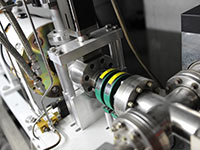 Electron Beam Processing
Electron Beam Processing
The electron beam (E-beam) irradiation process uses high-energy electrons for a variety of applications, such as the sterilization of single-use medical devices, contamination control of consumer products, and modification of materials, such as heat shrink tubing, wire and cables and molded parts.
What is Electron Beam Irradiation?
 In the electron beam process, a product is bombarded with high-energy electrons, resulting in a cascade of these electrons moving through the target material.
In the electron beam process, a product is bombarded with high-energy electrons, resulting in a cascade of these electrons moving through the target material.
The E-beam process utilizes high energy electrons as its radiation source. The electrons, which are produced by normal electrical current, are accelerated to near the speed of light by means of an accelerator. The electrons are focused to a scan horn of a defined size and scanned in a sweeping motion, creating a curtain of electrons. The product is then conveyed through the scan curtain at a tightly controlled and measured speed.
The process itself takes place behind a radiation shield, typically a large concrete structure, which prevents radiation from leaving the cell. As scanning occurs, the accelerated electrons inactivate any viable microorganisms.
What is Electron Beam Irradiation Used For?
Electron beam irradiation is a flexible and high-speed process that can be used for a variety of applications, including:
- Sterilization of single-use medical devices and pharmaceutical
- Contamination control in packaging, cosmetics, and toiletries
- Strengthening of polymers due to cross-linking and/or breaking down of polymers
What are the Benefits of Electron Beam?
E-beam irradiation can penetrate a wide range of materials and deliver the required irradiating dose in just a few seconds, meaning the entire process can take place in minutes. As a result of this short exposure period, the following benefits have been found:
- Optimized processing times
- Improved supply chain efficiencies
- Considerably less oxidative damage to the product
- Reduced color change in any present polymers
- No chemical residuals or induced radioactivity remain on processed products
Standards:
Electron beam sterilization is supported by the internationally recognized consensus standard, ISO 11137, which describes the approach to validating a process to achieve a defined sterility assurance level (SAL).
Electron Beam Irradiation Support Services:
In addition to irradiation sterilization, STERIS AST provides our Customers with laboratory testing and technical support solutions at every stage of the sterilization design process, from product development through routine processing.
Our Radiation TechTeam® guides Customers through the irradiation validation process, provides solutions for unique project needs, and supports routine processing through quarterly dose audits.
The Radiation Technology Center (RTC) supports our Customers with radiation test activities such as product trials, dose establishment and dose verification. The RTC provides high-precision dose delivery for validation, dose mapping, dose audit, and research purposes.
Our testing services provide Customers with validation support and microbial testing of their products processed with irradiation. As part of our complete radiation validation program, we will develop a protocol, assemble all testing and validation data, summarize results and make recommendations based on your product, as well as provide on-going support through a dedicated Radiation TechTeam Project Manager. Go here to learn more about our testing services available.
View our TechTeam Resources to learn more about the electron beam process.
Electron Beam Irradiation Summary

ELECTRON BEAM
Electron beam irradiation exposes products to high-energy electrons
![]()
Technology Variables
- Orientation to beam
- Beam energy
- Beam power
- Product conveyance
![]()
Product Considerations
- MATERIAL COMPATIBILITY
- Compatible with most materials
- DENSITY
- Moderate to low penetration on dense products
![]()
Possible Effects
Lower possible materials effects than gamma and X-ray
![]()
Exposure Time
- MINUTES
- (time varies based on dose requirements)
Why STERIS AST?
As a global leading sterilization and decontamination specialist, STERIS AST has over 40 years experience in providing safe and effective electron beam irradiation sterilization.
Related TechTips
Considerations When Establishing a Maximum Sterilization Dose for Radiation Processing
Per ISO 11137, products sterilized by X-ray, gamma, and E-beam irradiation require a documented and validated dose range. A dose range is composed of: A minimum dose based on the microbiologic considerations (type and quantity of organisms and their re
Irradiation’s Effect on Cannabis
Radiation technologies such as gamma and electron beam (E-beam) irradiation are commonly used treatment methods to address many of the safety concerns with herbal products, including cannabis. Radiation processing does not significantly affect the chemical or physical properties of cannabis and can effectively reduce microbial contamination to levels considered safe for human use.
Radiation Sterilization Master File Pilot Program FAQ
Q1: What is the Radiation Sterilization Master File Pilot Program? A:The Radiation Sterilization Master File Pilot Program (Pilot Program) is a voluntary program that intends to allow companies that terminally sterilize single-use medical devices using
Transferring of the Verification Dose from Electron Beam Technology to Photon Technology (Gamma or X-ray)
Background A verification (dose audit) or sterilization dose experiment requires a narrow and specific dose range to be applied to the samples used for tests of sterility as evidence that the routine minimum dose remains appropriate for delivering the



